The Paleobiota of the Klondike Mountain Formation comprises a diverse suite of Early Eocene plants and animals recovered in North Central Washington State from the Klondike Mountain Formation. The formation outcrops in locations across the north western area of Ferry County, with major sites in Republic, north west of Curlew Lake, and on the Toroda Creek area. The formation is the southern most of the Eocene Okanagan Highlands, sharing much of the paleoflora and paleofauna with site across Central and southern British Columbia.
Plants
Bryophytes
Dillhoff et al. (2013) reference undescribed moss specimens known from the Klondike Mountain Formation known from vegetative gametophytes and they noted them to be similar to undescribed specimens from the Allenby Formation and Horsefly shales.
| Family | Genus | Species | Authors | Year | Notes | Images |
|---|---|---|---|---|---|---|
|
Undescribed |
Undescribed |
Undescribed |
Undescribed moss specimens |
 |
Lycophytes
Rare specimens of Selaginella fossils were noted by Wehr (1998), with no species level description.
| Family | Genus | Species | Authors | Year | Notes | Images |
|---|---|---|---|---|---|---|
|
Undescribed |
A spikemoss |
 |
Pteridophytes
| Family | Genus | Species | Authors | Notes | Images |
|---|---|---|---|---|---|
|
Undescribed |
A possible bladder fern relative |
||||
|
Pigg et al. |
 | ||||
|
Undescribed |
A scouring rush |
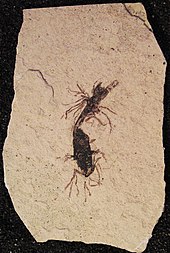 Not described | |||
|
Pigg et al. |
|||||
|
Undescribed |
A climbing fern |
||||
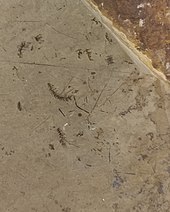 | |||||
|
Undescribed |
A "watermoss" species. |
 Not described |
Gymnosperms
Three major groups of gymnosperms are present in the Klondike Mountain Formation, with the most speciose being the pinophytes. The ginkgophytes are represented by two species of Ginkgo, while an undescribed Zamiaceae member is the sole cycadophyte.
Cycadophytes
| Family | Genus | Species | Authors | Notes | Images |
|---|---|---|---|---|---|
|
Undescribed |
Undescribed |
A zamiaceous cycad. |
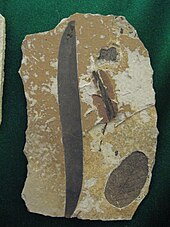 |
Gingkophytes
| Family | Genus | Species | Authors | Notes | Images |
|---|---|---|---|---|---|
| Ginkgoaceae | Ginkgo |
A ginkgo |
 | ||
|
A ginkgo |
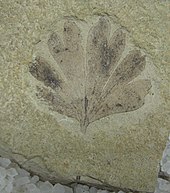 |
Pinophytes
| Family | Genus | Species | Authors | Notes | Images |
|---|---|---|---|---|---|
| Cupressaceae |
Undescribed |
An incense cedar |
|||
|
Undescribed |
A false cypress |
||||
|
Undescribed |
A sugi |
||||
|
Undescribed |
A Chinese swamp cypress |
||||
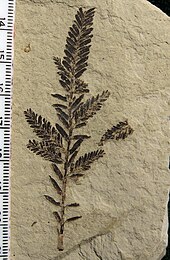 | |||||
|
A coast redwood |
 | ||||
|
Undescribed |
A Taiwania species |
||||
|
(Sternberg) Heer |
|||||
|
Undescribed |
An arborvitae |
||||
|
Undescribed |
A possible Thujopsis |
||||
| Pinaceae |
Oldest true fir described |
 | |||
|
Undescribed |
A spruce |
||||
| Pinus |
Berry |
A 5-needle pine |
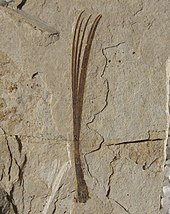 | ||
|
Berry |
A 3-needle pine, jr homonym to Pinus macrophylla Lindley 1839 |
 | |||
|
Berry |
A pine seed morphogenus |
 | |||
|
Berry |
A purported 4-needle pine |
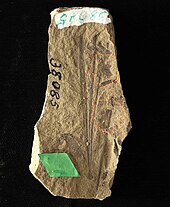 | |||
|
Gooch |
A golden larch |
 | |||
|
Undescribed |
A hemlock |
||||
|
Undescribed |
An umbrella pine |
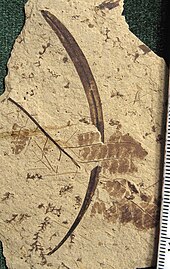 | |||
| Taxaceae |
Undescribed |
A yew |
 | ||
|
Undescribed |
A yew |
||||
|
Undescribed |
A yew |
||||
|
Undescribed |
A plum-yew relative |
Flowering plants
Angiosperms, commonly called flowering plants belong to a single plant clade which diverged from other plants during the prior to the Cretaceous, and began to rapidly evolve and radiate by the Middle Cretaceous. Angiosperm diversification during the Cretaceous and Paleocene resulted in eight recognized clades that are segregated into two groups the Basal angiosperms and Core angiosperms. Present in the Klondike Mountain Formation are four of the eight groups, Nymphaeales representing Basal Angiosperms, plus Magnoliids, Monocots, and Eudicots all in the Core angiosperms.
Nymphaeales
The Basal Angiosperms are represented by a single Nymphaeales water-lily species Nuphar carlquistii, though a second member, Allenbya collinsonae, has been described from the Princeton Chert. Wehr (1995) illustrated two fossils that were tentatively identified as fruits of the banana genus Ensete and the extinct myrtle genus Paleomyrtinaea respectively, however further fossil finds resulted in the re-identification of the first as a N. carlquistii rhizome section, and the second is a seed mass from the same water-lily.
| Family | Genus | Species | Authors | Notes | Images |
|---|---|---|---|---|---|
|
DeVore, Taylor, & Pigg |
A waterlily, |
 |
Magnoliids
Under the APG IV system of flowering plant classification, the magnoliids are divided into four orders Canellales, Laurales, Magnoliales, and Piperales. Member species and undescribed taxa placed confidently in the Laurales and Magnoliales are present in the formation. The laurales are the most diverse magnoliid order of the formation with one described species Sassafras hesperia plus three tentatively identified genera which have not been described. Of the magnoliales, only an undescribed Magnolia, having possible affinity with Magnolia subg. Talauma, is found in the formation, while Liriodendroxylon princetonensis has described from permineralized wood in the Princeton Chert. The extinct angiosperm genus Dillhoffia has noted similarities to the piperalean family Aristolochiaceae, but was left incertae sedis as to family by Manchester and Pigg (2008) due to a lack of confident morphological characters for placement. Piperales are known from the Princeton chert, with Saururus tuckerae representing the oldest confident Saururaceae species in the fossil record.
| Family | Genus | Species | Authors | Notes | Images |
|---|---|---|---|---|---|
| Lauraceae |
Undescribed |
A lauraceous form species. |
|||
|
Undescribed |
A stinkwood species. |
||||
|
Undescribed |
A Phoebe species. |
||||
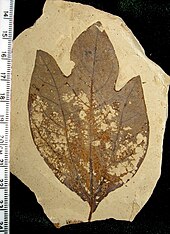 | |||||
|
Undescribed |
A magnolia, possibly Magnolia subgenus Talauma |
 | |||
|
Manchester & Pigg |
A flower of uncertain floral affinity |
 |
Monocots
The second largest clade of flowering plants, monocots are divided into eleven separate orders and of those, the Alismatales, Asparagales, Liliales, and Poales are found in the Klondike Mountain Formation, each represented by a single taxon. The Alismatales are represented by the Araceae species Orontium wolfei, which is considered similar to the modern golden clubs of eastern North America, while the extinct Paleoallium belongs to the Liliales. Asparagales and Poales are both present as undescribed species associated with the genera Smilax and Typha respectively. Extinct genera of monocots are also represented in the Princeton chert by the arecalean palm Uhlia, the alismatalean genus Heleophyton, the alismatalean Keratosperma, the asparagalean pollen morphogenus Pararisteapollis, the lilialean genus Soleredera, and the poalean genus Ethela,
| Family | Genus | Species | Authors | Notes | Images |
|---|---|---|---|---|---|
|
Pigg, Bryan, & DeVore |
An onion relative |
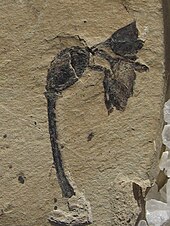 | |||
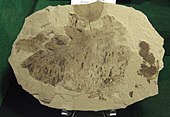 | |||||
|
Undescribed |
A greenbrier species. |
||||
|
Undescribed |
A cattail species. |
Eudicots

Over a dozen different Rosaceae genera, both extant and extinct, have been identified in the formation providing some of the oldest reliable macrofossil records (excluding fossil pollen) for the family. Benedict et al. (2011) described first fossils for the prunoid genus Oemleria along with the oldest Prunus flowers. The Prunus flowers are complemented by leaf fossils representing five to six distinct morphotypes. Spiraea is known from an inflorescence with multiple flowers and leaves that are either from the genus or a closely related extinct type. The leaves frequently are preserved with a persistent stipule, a feature not found in modern Spiraea species. The firethorn genus Pyracantha and the South American genus Hesperomeles have been tentatively identified from leaves while Maloidea leaves belonging to either Malus or Pyrus have been found. Two distinct species of the Asian endemic genus Photinia are known, however only one of them Photinia pagae had been described as of 2007. The rosaceous genus Physocarpus had been reported by Hopkins and Wehr (1994) as also occurring in the formation, however subsequent examination of the fossils by Oh & Potter (2005) failed to find stellate trichomes which are a distinct feature of the genus. They noted the fossils might be stem Neillieae, the rose tribe containing both Physocarpus and Neillia, or possibly Rubus, Crataegus, or Ribes.
Fossils of both Sorbus and Rhus species leaves showing evidence of being interspecies hybrids have been noted from the formation and Flynn, DeVore and Pigg (2019) described four species of sumac which formed multiple hybrids. Between three and four Trochodendraceae species that have been described from the Klondike Mountain Formation. Broadly circumscribed four species in three genera have been identified at Republic, Paraconcavistylon wehrii, Pentacentron sternhartae, Tetracentron hopkinsii, and Trochodendron nastae. Additionally the species Trochodendron drachukii is known from related Kamloops group shales at the McAbee Fossil Beds near Cache Creek, British Columbia. Manchester et al. 2018 noted that Tr. drachukii is likely the fruits of Tr. nastae, while Pe. sternhartae are likely the fruits of Te. hopkinsii. If fossils of the fruits and foliage in attachment are found, that would bring the species count down to three whole plant taxa. Additionally, the extinct genus Nordenskioldia is also known from the formation. The placement of Nordenskioldia is debated, with some treatments placing it into Trochodendraceae, while a 2020 analysis placed it outside of the crown-group Trochodendaceae. Wesley Wehr in 1994 reported Bignoniaceae seeds along with a single Rubiaceae fruit and an isolated Fabaceae leaf. An update of the floral list by Wehr and Manchester published in 1996 added an additional fifteen taxa identified from reproductive structures such as flowers fruits or seeds.
Pigg, Manchester, and Wehr (2003) noted in during the description of Corylus johnsonii and Carpinus perryae that they were the oldest confirmed hazelnut and hornbeam fossils. That status was affirmed by Forest et al. (2005) who used both as fossil calibration points for phylogenetic analysis of Betulaceae. Within the family Bignoniaceae, the fossil seeds and fruits are noted by Ze-Long Nie et al (2006) as the oldest confirmed for the family.
| Family | Genus | Species | Authors | Notes | Images |
|---|---|---|---|---|---|
| Anacardiaceae | Rhus |
Flynn, DeVore, & Pigg |
A sumac, |
 | |
|
Flynn, DeVore, & Pigg |
A sumac, |
 | |||
|
(Wolfe and Wehr) Flynn, DeVore & Pigg |
A sumac, |
 | |||
|
Flynn, DeVore, & Pigg |
A sumac, |
||||
|
Undescribed |
A holly |
||||
|
Undescribed |
A spikenard species |
||||
| Betulaceae |
(Berry) Wolfe & Wehr |
An Alder |
 | ||
|
Wolfe & Wehr |
A birch |
 | |||
|
Pigg, Manchester, & Wehr |
A hornbeam |
 | |||
|
Pigg, Manchester, & Wehr |
 | ||||
| †Palaeocarpinus |
Pigg, Manchester, & Wehr |
A birch relative |
 | ||
|
Undescribed |
A birch relative |
 | |||
|
Undescribed |
Undescribed |
A catalpa family member |
 | ||
|
Wolfe & Wehr |
An extinct Bursera relative |
 | |||
|
Undescribed |
A cannabaceous fruit |
 | |||
|
(Dawson) Wolfe & Wehr |
A katsura with suggested affinity to †Joffrea, |
 | |||
|
Undescribed |
A dogwood species, |
||||
|
Undescribed |
An elaeocarpaceous fruit |
 | |||
| Ericaceae |
Undescribed |
A madrone relative |
|||
|
Undescribed |
A rhododendron |
||||
|
Undescribed |
A doghobble relative |
||||
|
A "hard rubber tree" |
 | ||||
| Fagaceae |
Undescribed |
A Castanea relative |
|||
|
(Knowlton) Wolfe & Wehr |
A beech relative |
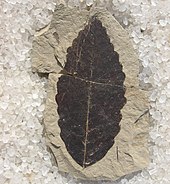 | |||
|
Manchester & Dillhoff |
A beech |
 | |||
|
Undescribed |
An oak |
||||
| Grossulariaceae | Ribes |
"Species 1" |
A current |
||
|
"Species2" |
A current |
||||
| Hamamelidaceae |
 | ||||
|
Radtke, Pigg, & Wehr |
 | ||||
| Hydrangeaceae |
Undescribed |
A Hydrangea. |
|||
|
Undescribed |
A mock-orange |
||||
|
Unidentified |
A Phytocrene relative |
||||
|
Undescribed |
A virginia willow species |
||||
| Juglandaceae |
Undescribed |
A walnut family relative. |
|||
|
(Brown) Manchester |
A walnut family relative. |
||||
|
Undescribed |
A walnut family relative. |
||||
|
Undescribed |
A wing nut |
||||
|
Undescribed |
A swamp loosestrife |
||||
| Malvaceae |
Undescribed |
A Craigia species |
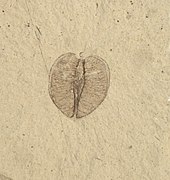 | ||
|
A chocolate relative |
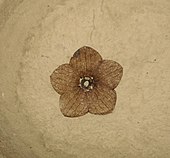 | ||||
|
Undescribed |
A hibiscus |
||||
|
Undescribed |
A linden relative |
||||
|
Wolfe & Wehr |
A Linden |
 | |||
|
Undescribed |
Linden relative fruits |
 | |||
|
(LaMotte) Wolfe & Wehr |
First described as a dogwood under "Cornus acuminata |
 | |||
|
Undescribed |
A moonseed |
||||
|
Undescribed |
A mulberry, two types known. |
||||
|
Dawson |
 | ||||
|
Wolfe & Wehr |
A dove-tree relative |
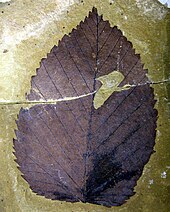 | |||
|
Undescribed |
A leaf morphotype of uncertain affiliation. |
||||
| Platanaceae |
Huegele & Manchester |
A plane tree fruit taxon affiliated with Langeria |
|||
|
Wolfe & Wehr |
A plane tree |
 | |||
|
Undescribed |
Manchester |
A plane tree fruit taxon |
 | ||
|
(Lesquereux) Wolfe & Wehr |
A plane tree relative |
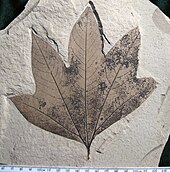 | |||
|
Undescribed |
A sycamore stamen head |
 | |||
|
Undescribed |
A milkwort relative |
 | |||
|
Undescribed |
A Clematis |
 | |||
| Rosaceae |
Undescribed |
A service berry |
|||
|
Undescribed |
A hawthorn relative |
||||
|
Undescribed |
An apple |
||||
|
Undescribed |
A maloid species possibly apple or pear |
||||
|
Undescribed |
A snow-wreath |
||||
|
Benedict, DeVore, & Pigg |
An Osoberry |
||||
|
Wolfe & Wehr |
A Christmas-berry relative |
 | |||
|
Undescribed |
A possible nine-bark |
||||
| Prunus |
Benedict, DeVore, & Pigg |
A cherry relative |
 | ||
|
"Species 1" |
A prunoid leaf |
||||
|
"Species 2" |
A prunoid leaf |
||||
|
"Species 3" |
A prunoid leaf |
||||
|
Undescribed |
A firethorn sp. |
||||
|
Undescribed |
A maloid species possibly apple or pear |
||||
|
Undescribed |
A blackberry |
||||
|
Undescribed |
A rowan relative |
||||
|
Undescribed |
A bridal wreath |
||||
|
Undescribed |
A bridal wreath relative |
||||
| Sabiaceae |
Undescribed |
A Meliosma species |
|||
|
Undescribed |
A Sabia species |
||||
| Salicaceae |
Undescribed |
A cottonwood |
|||
|
Undescribed |
A willow relative |
||||
|
Undescribed |
A willow |
||||
| Sapindaceae |
Acer? |
Heer, 1876 |
A possible maple |
||
| Acer |
A maple |
||||
|
Wolfe & Tanai |
A maple |
||||
|
Wolfe & Tanai |
A maple |
||||
|
Wolfe & Tanai |
A maple |
||||
|
Wolfe & Tanai |
A maple |
||||
|
Wolfe & Tanai |
A maple |
||||
|
Wolfe & Tanai |
A maple |
||||
|
Undescribed |
A horse chestnut |
||||
|
Becker |
A sapindaceous species |
 | |||
|
(Brown) Wolf & Wehr |
An extinct sapindalean species |
 | |||
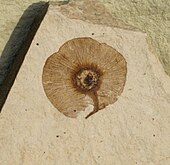 | |||||
|
Wang et al. |
A Koelreuteria species |
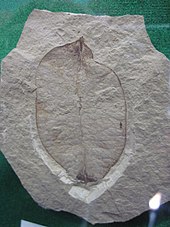 | |||
|
Undescribed |
A kadsura species. |
||||
| Theaceae |
"Species A" |
A theaceous species similar to Gordonia |
|||
|
"Species B" |
A theaceous species similar to Cleyera |
||||
|
Undescribed |
A trochodendroid of uncertain placement. |
||||
| Trochodendraceae |
(Manchester et al.) |
A Trochodendrale |
|||
|
Manchester et al. |
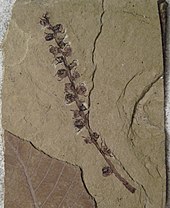 | ||||
|
Pigg et al. |
A Trochodendrale, |
 | |||
|
Pigg, Wehr, & Ickert-Bond |
A Trochodendron |
 | |||
|
Undescribed |
A trochodendroid of uncertain placement. |
 | |||
| Ulmaceae |
Undescribed |
An elm relative |
|||
| Ulmus |
(Berry) LaMotte |
An elm species |
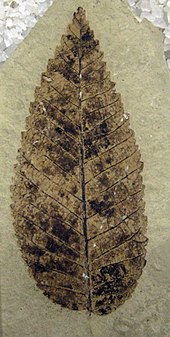 | ||
|
Denk & Dillhoff |
An elm species, |
 | |||
|
Undescribed |
Grape seeds and leaves |
||||
| Incertae sedis |
Crane |
A winged fruit of unidentified affinities |
 | ||
|
Smith, Greenwalt & Manchester |
A samara of uncertain affiliation. |
 | |||
|
Manchester |
A samara of uncertain affinities. |
 | |||
|
Wolfe & Wehr |
An incertae sedis angiosperm |
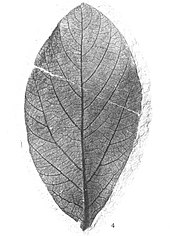 |
Animals
Arthropods
The insect fauna of the Klondike Mountain Formation includes representatives from over 13 orders, based on a 1992 estimate, including immature though adult specimens and both terrestrial and aquatic taxa. The most prevalent orders are Diptera and Hemiptera, each making up approximately 30% of the fossil insects known in 1992.
Blattodea
| Family | Genus | species | Authors | Notes | Images |
|---|---|---|---|---|---|
|
Undescribed |
Undescribed |
A Diplopterine cockroach |
|||
|
Undescribed |
Undescribed |
A blattoidean cockroach |
 | ||
|
Undescribed |
Undescribed |
Undescribed termites of uncertain affiliation |
 |
Coleoptera
A list of Coleopteran families identified by 1992 included Carabidae, Cerambycidae, Chrysomelidae, Curculionidae, Dytiscidae, Elateridae and Lucanidae, but the beetle fauna has not been described in depth yet, with only two weevil species having been fully described. A third beetle group belonging to the bean beetle tribe Pachymerini has been identified as palm beetles of the Caryobruchus–Speciomerus genus group.
| Family | Genus | Species | Authors | Notes | Images |
|---|---|---|---|---|---|
| Brentidae |
Legalov, 2013 |
 | |||
|
Legalov, 2015 |
|||||
|
Undescribed |
Undescribed |
A ground beetle |
 | ||
|
Undescribed |
Undescribed |
A long-horn beetle |
|||
|
Caryobruchus–Speciomerus genus group |
Undescribed |
palm beetles in the tribe Pachymerini. |
|||
|
Undescribed |
Undescribed |
A diving beetle |
|||
|
Undescribed |
Undescribed |
A click beetle |
|||
|
Undescribed |
Undescribed |
A stag beetle |
|||
|
Unidentified |
Undescribed |
Undescribed |
A possible staphylinoid beetle |
Dermaptera
The order Dermaptera was first reported in 1992 and is known from a series of isolated partial specimens, mostly abdominal sections with the distinct anal forceps attached. Based on the forceps structuring the specimens were tentatively assigned to the modern family Forficulidae, as the oldest North American representatives of the family known at that time.
| Family | Genus | Species | Authors | Notes | Images |
|---|---|---|---|---|---|
| Forficulidae? | Unidentified |
"Forficulid species 1" |
A possible forficulid earwig with long cerci |
 | |
|
"Forficulid species 2" |
A possible forficulid earwig with short cerci |
 undescribed |
Diptera
| Family | Genus | Species | Authors | Notes | Images |
|---|---|---|---|---|---|
|
Undescribed |
Undescribed |
A march fly |
 | ||
|
Undescribed |
Undescribed |
Trace fossils |
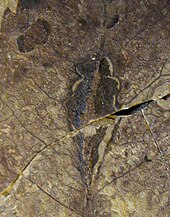 | ||
|
Undescribed |
Undescribed |
A dagger fly |
|||
|
Undescribed |
Undescribed |
A fungus gnat |
|||
|
A pipunculid big-headed fly |
 | ||||
|
Unidentified |
Unidentified |
A hover fly |
|||
|
Undescribed |
Undescribed |
A crane fly |
 |
Ephemeroptera
Lewis (1992) listed one species of Heptageniidae and three specimens that he did not place to family. The next year Lewis and Wehr (1993) gave a slightly more detailed description of the specimens again identifying one to Heptageniidae, possibly in the genera Heptagenia or Stenonema. The specimens were later examined by Nina D. Sinitchenkova (1999) who described one as a squaregill mayfly and the oldest member of the genus Neoephemera, confirmed the Heptageniidae identification but that it was unidentifiable to genus. The last specimen she confirmed as an ephemeropteran, but unidentifiable below order level.
| Family | Genus | Species | Authors | Notes | Images |
|---|---|---|---|---|---|
|
Indeterminate |
Indeterminate |
A flat headed mayfly nymph. |
 | ||
|
Sinitchenkova, 1999 |
Hemiptera
| Family | Genus | Species | Authors | Notes | Images |
|---|---|---|---|---|---|
|
Undescribed |
Undescribed |
An aphid |
|||
| Aphrophoridae |
Undescribed |
An aphrophorid spittlebug |
 | ||
|
Undescribed |
An aphrophorid spittlebug |
||||
| Cercopidae |
Undescribed |
A cercopid froghopper |
|||
|
Undescribed |
Undescribed |
A cercopid froghopper |
 | ||
|
Undescribed |
Undescribed |
A frog hopper |
|||
|
Undescribed |
Undescribed |
A Shield or stink bug |
 |
Hymenoptera
A review of the Okanagan highlands hymenoptera published in 2018 identified four "Symphyta" families in the formation Cimbicidae, Pamphiliidae, Siricidae, and Tenthredinidae. Of the "Apocrita" families thirteen are represented, the "Parasitica" families are Braconidae, Diapriidae Ichneumonidae, Proctotrupidae, and Roproniidae while the Vespoidea families are Formicidae, Pompilidae, Scoliidae and Vespidae. Within Apoidea the "Spheciformes" families include Angarosphecidae and Sphecidae while Halictidae is the sole "Apiformes" family known from body fossils. Prunus and Ulmus leaves have been found having damage that is consistent with the damage pattern left by Megachilidae species bees when they remove sections of tissue for nest lining. There are several additional Apoidea fossils that were left as incertae sedis in the group based on the similarity between them and Paleorhopalosoma menatensis, a Paleocene species described from the Menat Formation Auvergne, France. The placement of P. menatensis is uncertain, having been initially described as a member of Rhopalosomatidae, but is possibly an Angarosphecidae or closely related taxon, based on the wing and body morphology.
| Family | Genus | Species | Authors | Notes | Images |
|---|---|---|---|---|---|
| Angarosphecidae |
Undescribed |
An angarosphecid spheciform wasp. |
|||
|
Undescribed |
Undescribed |
An angarosphecid spheciform wasp |
|||
|
Undescribed |
Undescribed |
braconid parasitic wasps |
 | ||
| Cimbicidae | †Leptostigma |
Archibald & Rasnitsyn, 2023 |
|||
|
Archibald & Rasnitsyn, 2023 |
A cenocimbicine cimbicid sawfly |
 | |||
|
Undescribed |
Undescribed |
Trace fossils |
 | ||
|
Undescribed |
Undescribed |
A diapriid diaprioid wasp |
|||
| Formicidae |
Dlussky & Rasnitsyn, 2003 |
An ant of uncertain subfamily affiliation |
|||
|
"Indesterminate" |
 | ||||
|
(Dlussky & Rasnitsyn, 1999) |
An ant, described as Camponotites kraussei, |
||||
|
Dlussky & Rasnitsyn, 1999 |
A bulldog ant, first described as a Rhopalosomatidae wasp, |
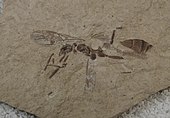 | |||
|
Undescribed |
Undescribed |
Ants of uncertain subfamily placement. |
 | ||
|
Halictidae (?) |
Undescribed |
Undescribed |
A possible sweat bee |
||
|
Undescribed |
Undescribed |
ichneumonid parasitic wasps unplaced to subfamily |
 | ||
|
Undescribed |
Undescribed |
Megachilid leaf-cutter bee herbivory trace fossils on leaves |
|||
|
Archibald & Rasnitsyn, 2015 |
A parasitic wasp |
||||
|
Undescribed |
Undescribed |
A pompilid spider wasp |
|||
|
Undescribed |
Undescribed |
A proctotrupid parasitic wasp |
|||
|
Undescribed |
Undescribed |
A roproniid (sensu lato) proctotrupoid wasp |
|||
|
Archibald & Rasnitsyn, 2022 |
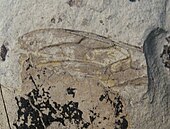 | ||||
|
Undescribed |
Undescribed |
An archaeoscoliine scoliid wasps |
|||
|
Undescribed |
Undescribed |
A sphecid (sensu stricto) wasp |
|||
|
Undescribed |
Undescribed |
A Tenthredinid sawfly |
|||
|
Undescribed |
Undescribed |
A vespid wasp |
Lepidoptera
A solitary lepidopteran body fossil has been recovered, but no full descriptive work has been made on the specimen, aside from a single PhD dissertation. Early examination placed the moth in the family Geometridae, but later work has identified it as the oldest member of the tiger moth subfamily Arctiinae. Trace fossil evidence from leaf fossil herbivory indicates at least four other possible lepidopteran families were present in the formation.
| Family | Genus | Species | Authors | Notes | Images |
|---|---|---|---|---|---|
|
Undescribed |
Undescribed |
Trace fossils |
|||
|
Undescribed |
Undescribed |
An arctiine tiger moth |
 undescribed | ||
|
Undescribed |
Undescribed |
Trace fossils |
|||
|
Undescribed |
Trace fossils |
||||
|
Undescribed |
Trace fossils |
Mecoptera
A number of mecopteran species belonging to the families Cimbrophlebiidae, Dinopanorpidae, Eorpidae, and Panorpidae are also known.
| Family | Genus | Species | Authors | Notes | Images |
|---|---|---|---|---|---|
| †Cimbrophlebiidae | †Cimbrophlebia |
Archibald, 2009 |
 | ||
|
Archibald, 2009 |
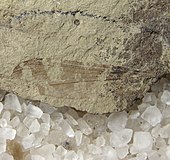 | ||||
| †Dinopanorpidae | †Dinokanaga |
Archibald, 2005 |
A scorpion fly species |
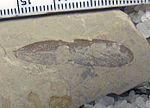 | |
|
Archibald, 2005 |
A scorpion fly species |
 | |||
|
Archibald, 2005 |
A scorpion fly species |
||||
| †Eorpidae | †Eorpa |
Archibald, Mathewes, & Greenwood, 2013 |
A mecopteran scorpionfly |
 | |
|
Archibald, Mathewes, & Greenwood, 2013 |
A mecopteran scorpionfly, tentatively identified |
 | |||
|
Undescribed |
Undescribed |
Undescribed common scorpionflies |
Neuroptera
The neuropteran insects (lacewings and their allies) identified as of 2014 include species from the families Berothidae, Chrysopidae, Hemerobiidae, Ithonidae (including Polystoechotidae), Nymphidae, Osmylidae, and Psychopsidae.
| Family | Genus | Species | Authors | Year | Notes | Images |
|---|---|---|---|---|---|---|
|
2013 |
 | |||||
|
(Makarkin, Archibald, & Oswald, 2003) |
2003 |
A hemerobiid lacewing |
||||
| Ithonidae |
Makarkin & Archibald, 2009 |
2009 |
 | |||
| †Palaeopsychops |
Archibald & Makarkin, 2006 |
2006 |
A polystechotid group moth lacewing |
 | ||
|
Archibald & Makarkin, 2006 |
2006 |
A polystechotid group moth lacewing |
 | |||
| †Polystoechotites |
Archibald & Makarkin, 2006 |
2006 |
A polystechotid group moth lacewing |
 | ||
|
Archibald & Makarkin, 2006 |
2006 |
A polystechotid group moth lacewing |
 | |||
|
Archibald & Makarkin, 2006 |
2006 |
A polystechotid group moth lacewing |
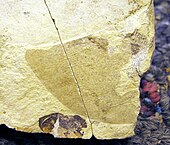 | |||
|
Archibald, Makarkin, & Ansorge, 2009 |
2009 |
A nymphid lacewing, possibly a species of †Epinesydrion |
 | |||
|
Makarkin, Archibald, & Mathewes, 2021 |
2021 |
|||||
|
Makarkin & Archibald, 2014 |
2014 |
A possible psychopsid lacewing |
 |
Odonata
| Family | Genus | Species | Authors | Year | Notes | Images |
|---|---|---|---|---|---|---|
| Aeshnidae |
Archibald & Cannings, 2019 |
2019 |
 | |||
|
Archibald & Cannings, 2019 |
2019 |
 | ||||
|
Archibald & Cannings, 2019 |
2019 |
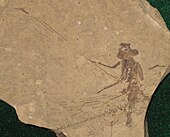 | ||||
| †Dysagrionidae |
Archibald & Cannings, 2021 |
2021 |
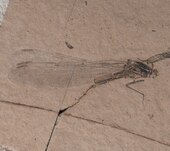 | |||
|
Archibald & Cannings, 2021 |
2021 |
 | ||||
| †Okanagrion |
Archibald & Cannings, 2021 |
2021 |
 | |||
|
Archibald & Cannings, 2021 |
2021 |
 | ||||
|
Archibald & Cannings, 2021 |
2021 |
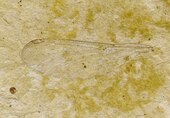 | ||||
|
Archibald & Cannings, 2021 |
2021 |
 | ||||
|
Archibald & Cannings, 2021 |
2021 |
 | ||||
|
Archibald & Cannings, 2021 |
2021 |
 | ||||
|
Archibald & Cannings, 2021 |
2021 |
 | ||||
|
Archibald & Cannings, 2021 |
2021 |
A gossamerwing damselfly. |
 | |||
|
Archibald & Cannings |
2021 |
 |
Orthoptera
| Family | Genus | Species | Authors | Year | Notes | Images |
|---|---|---|---|---|---|---|
|
Archibald, Gu, & Mathewes |
2022 |
A grasshopper/hump-back grig relative |
 |
Phasmatodea
Fossil wings first described in 2015 were identified as being from Susumanioidea stick-insects, a group that had previously been known from the Jurassic to the Paleocene only. Archibald and Bradler (2015) did not place Eoprephasma into Susumaniidae family, maintaining that known characters of the describe specimens did not match taxa in the family, they instead kept the genus as Susumanioidea incertae sedis. Phylogenetic analysis of Susumanioidea published by Yang et al. (2021) resulted in placement of Eoprephasma as the sister group to Renphasma deep within the Susumaniidae subfamily Susumaniinae. The phylogeny produced by Yang et al. indicated a sister group state with the Cretaceous genus Renphasma of China, and placed both as the most derived of the Susumaniinae taxa.
| Family | Genus | Species | Authors | Year | Notes | Images |
|---|---|---|---|---|---|---|
|
Archibald & Bradler, 2015 |
2015 |
A Susumaniinae stick insect species |
Raphidioptera
| Family | Genus | Species | Authors | Year | Notes | Images |
|---|---|---|---|---|---|---|
|
Archibald & Makarkin, 2021 |
2021 |
Trichoptera
Trichopterans are known mainly from laraval cases and occasional isolated wings.
| Family | Genus | species | Authors | Year | Notes | Images |
|---|---|---|---|---|---|---|
|
Unidentified |
Unidentified |
giant caddisflies |
||||
|
Unidentified |
unidentified |
northern caddisflies |
Vertebrates
Five species of fish have been identified from the formation, four of which are known from skeletal elements, while the fifth is only known from isolated scales. Of the five species, two are unique to the formation, Hiodon woodruffi and Libotonius pearsoni were both described by paleoichthyologist Mark V. H. Wilson in 1978 and 1979 respectively. The other three species, "Amia" hesperia, Amyzon aggregatum, and Eosalmo driftwoodensis, were first described from Okanagan Highlands formations in British Columbia and subsequently also identified from Ferry County fossils. The first notation of fish fossils in the Republic area was by Joseph Umpleby in his 1910 visit to the area, who collected fish near the Tom Thumb Mine, and sent them to the National Museum of Natural History. After examining the fossils, Charles R. Eastman listed the specimens as belonging to the extinct species Amyzon brevipinne in his Fossil fishes in the collection of the United States National Museum. Research tapered off until a series of fish were collected in the Toroda Creek Graben northwest of Republic by Robert Carl Pearson during his early 1960's field mapping for the Geologic map of the Bodie Mountain quadrangle, Ferry and Okanogan Counties, Washington. The fossils were tentatively identified by paleoichthyologist David Dunkle in 1962 and 1965 as members of the genera Amyzon, Tricophanes, Erismatopterus and an undefined salmonid. Pearson sent almost all of the specimens collected to the Smithsonian, but the fossils were never accessioned into the collections and are now considered lost. He did retain one fossil from the initial collection which was later donated to the USGS collections. The largest single work on the fish of the Okanagan Highlands was published by Mark Wilson in 1977 and covered fossils collected from the known British Columbian Okanagan Highlands fossil sites of the time. While not covering the Washington State fossils, Wilson named two of the species that are currently recognized from the Klondike Mountain Formation Amyzon aggregatum and Eosalmo driftwoodensis. Additionally scales attributed to the genus Amia were discussed and the genus Libotonius was named from fossils in the Allenby Formation. In the late 1960s a collection of fish from near the Tom Thumb Mine in Republic was compiled by resident R. Woodward. During the summers of 1976 and 1977 the University of Alberta conducted field collecting in both the Republic and Toroda Creek areas, along with the donation of the Woodward collection, yielded a number of fossil catostomids, along with a single percopsid, a salmonid, a hiodontid, and an Amia scale. The hiodontids were subsequently described as the species Eohiodon woodruffi in 1978 based on differences between the Tom thumb Tuff fossils and those found in British Columbian sites. A year later the percopsid fossils were also described as Libotonius pearsoni, extending the range of the genus south from the Allenby Formation.
Bird fossils are limited to mostly isolated feathers that are preserved in the finer grained strata of the lake bed, though one partial bird skeleton has also been recovered.
| Family | Genus | Species | Authors | Year | Notes | Images |
|---|---|---|---|---|---|---|
|
Wilson, 1977 |
1977 |
A bowfin, known from isolated scales |
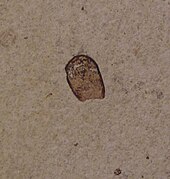 | |||
|
Wilson, 1977 |
1977 |
A sucker |
 | |||
|
Unidentified |
(Wilson, 1977) |
1977 |
A sucker, originally identified as Amyzon aggregatum |
|||
|
Wilson, 1977 |
1999 |
A Salmon |
 | |||
|
Wilson, 1978 |
1978 |
A mooneye, first described as "Eohiodon" woodruffi. |
 | |||
|
Wilson, 1979 |
1979 |
A sand roller relative. |
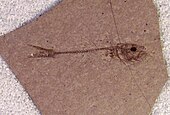 | |||
|
incertae sedis (Aves) |
Unidentified |
"Unnamed" |
2019 |
indeterminate feathers and a skeleton |
 |
References
- ^ Dillhoff, R.M.; Dillhoff, T.A.; Greenwood, D.R.; DeVore, M.L.; Pigg, K.B. (2013). "The Eocene Thomas Ranch flora, Allenby Formation, Princeton, British Columbia, Canada". Botany. 91 (8): 514–529. doi:10.1139/cjb-2012-0313.
- ^ Wehr, W. "Middle Eocene insects and plants of the Okanogan Highlands". In Martin, J. (ed.). Contributions to the Paleontology and Geology of the West Coast. Seattle, Washington: University of Washington Press. pp. 99–109.
- ^ Pigg, K. B.; DeVore, M. L.; Greenwood, D. R.; Sundue, M. A.; Schwartsburd, P.; Basinger, J. F. (2021). "Fossil Dennstaedtiaceae and Hymenophyllaceae from the Early Eocene of the Pacific Northwest". International Journal of Plant Sciences. 182 (9): 793–807. doi:10.1086/715633. S2CID 239036762.
- Joseph, N. L. (1988). "Important Eocene Flora and Fauna Unearthed at Republic, Washington". Rocks & Minerals. 63 (2): 146–151. Bibcode:1988RoMin..63..146J. doi:10.1080/00357529.1988.11761830.
- ^ Greenwood, D.R.; Archibald, S.B.; Mathewes, R.W; Moss, P.T. (2005). "Fossil biotas from the Okanagan Highlands, southern British Columbia and northeastern Washington State: climates and ecosystems across an Eocene landscape". Canadian Journal of Earth Sciences. 42 (2): 167–185. Bibcode:2005CaJES..42..167G. doi:10.1139/e04-100.
- Arnold, C. A. (1955). "A Tertiary Azolla from British Columbia" (PDF). Contributions from the Museum of Paleontology, University of Michigan. 12 (4): 37–45.
- ^ Greenwood, D.R.; Pigg, K.B.; Basinger, J.F.; DeVore, M.L. (2016). "A review of paleobotanical studies of the Early Eocene Okanagan (Okanogan) Highlands floras of British Columbia, Canada, and Washington, U.S.A." Canadian Journal of Earth Sciences. 53 (6): 548–564. Bibcode:2016CaJES..53..548G. doi:10.1139/cjes-2015-0177. hdl:1807/71961.
- Hopkins, D.; Johnson, K. (1997). "First Record of cycad leaves from the Eocene Republic flora" (PDF). Washington Geology. 25 (4): 37. Retrieved 29 September 2021.
- ^ Dillhoff, R.M.; Leopold, E.B.; Manchester, S.R. (2005). "The McAbee flora of British Columbia and its relations to the Early-Middle Eocene Okanagan Highlands flora of the Pacific Northwest" (PDF). Canadian Journal of Earth Sciences. 42 (2): 151–166. Bibcode:2005CaJES..42..151D. doi:10.1139/e04-084.
- ^ Mustoe, G.E. (2002). "Eocene Ginkgo leaf fossils from the Pacific Northwest". Canadian Journal of Botany. 80 (10): 1078–1087. doi:10.1139/b02-097.
- Mathewes, R. W.; Greenwood, D. R.; Archibald, S. B. (2016). "Paleoenvironment of the Quilchena flora, British Columbia, during the Early Eocene Climatic Optimum" (PDF). Canadian Journal of Earth Sciences. 53 (6): 574–590. Bibcode:2016CaJES..53..574M. doi:10.1139/cjes-2015-0163. hdl:1807/71979.
- ^ Schorn, H. E.; Wehr, W. C. (1996). "The conifer flora from the Eocene uplands at Republic, Washington". Washington Geology. 24 (2): 22–24.
- ^ "Conifers and Ginkgos". Burke Museum Paleobotany Project. Retrieved 28 May 2023.
- Terry, R.; Pyne, M.; Bartel, J.; Adams, R. (2016). "A molecular biogeography of the New World cypresses (Callitropsis, Hesperocyparis; Cupressaceae)". Plant Systematics and Evolution. 302 (7): 921–942. Bibcode:2016PSyEv.302..921T. doi:10.1007/s00606-016-1308-4. JSTOR 44853291. S2CID 4236846.
- ^ Chaney, R.W. (1951). "A revision of fossil Sequoia and Taxodium in western North America based on the recent discovery of Metasequoia". Transactions of the American Philosophical Society. 40 (3): 231.
- ^ Wolfe, J.A.; Wehr, W.C. (1987). Middle Eocene dicotyledonous plants from Republic, northeastern Washington (Report). Bulletin. Vol. 1597. United States Geological Survey. pp. 1–25. doi:10.3133/b1597.
- ^ Berry, E.W. (1929). A revision of the flora of the Latah Formation (Report). Professional Paper. United States Geological Survey. pp. 225–265. doi:10.3133/pp154h. 154-H.
- Schorn, H.; Wehr, W. (1986). "Abies milleri, sp. nov., from the Middle Eocene Klondike Mountain Formation, Republic, Ferry County, Washington". Burke Museum Contributions in Anthropology and Natural History (1): 1–7.
- ^ Gooch, N. L. (1992). "Two new species of Pseudolarix Gordon (Pinaceae) from the middle Eocene of the Pacific Northwest". PaleoBios. 14: 13–19.
- LaMotte, R.S. (1944). "Supplement to catalogue of Mesozoic and Cenozoic plants of North America, 1919–37". United States Geological Survey Bulletin. 924: 307. Bibcode:1944usgs.rept....5L. doi:10.3133/b924. hdl:2027/mdp.39015095011311.
- Jiao, Y; et al. (2011). "Ancestral polyploidy in seed plants and angiosperms". Nature. 473 (7345): 97–100. Bibcode:2011Natur.473...97J. doi:10.1038/nature09916. PMID 21478875. S2CID 4313258.
- ^ DeVore, ML; Taylor, W; Pigg, KB (2015). "Nuphar carlquistii sp. nov. (Nymphaeaceae): A Water Lily from the Latest Early Eocene, Republic, Washington". International Journal of Plant Sciences. 176 (4): 365–377. doi:10.1086/680482. S2CID 84149074.
- Cevallos-Ferriz, S. R.; Stockey, R. A. (1989). "Permineralized fruits and seeds from the Princeton chert (Middle Eocene) of British Columbia: Nymphaeaceae". Botanical Gazette. 150 (2): 207–217. doi:10.1086/337765. S2CID 86651676.
- ^ Wehr, W.C. (1995). "Paleobotanical Significance of Eocene Flowers, Fruits, and Seeds from Republic, Washington". Washington Geology. 24 (2): 25–2.
- Cevallos-Ferriz, S. R.; Stockey, R. A. (1990). "Vegetative remains of the Magnoliaceae from the Princeton chert (middle Eocene) of British Columbia". Canadian Journal of Botany. 68 (6): 1327–1339. doi:10.1139/b90-169.
- Smith, S. Y.; Stockey, R. A. (2007). "Establishing a fossil record for the perianthless Piperales: Saururus tuckerae sp. nov.(Saururaceae) from the Middle Eocene Princeton Chert". American Journal of Botany. 94 (10): 1642–1657. doi:10.3732/ajb.94.10.1642. PMID 21636361.
- ^ Wehr, W. C.; Hopkins, D. Q. (1994). "The Eocene orchards and gardens of Republic, Washington". Washington Geology. 22 (3): 27–34.
- Manchester, S.; Pigg, K. (2008). "The Eocene mystery flower of McAbee, British Columbia". Botany. 86 (9): 1034–1038. doi:10.1139/B08-044.
- Erwin, D.M.; Stockey, R.A. (1994). "Permineralized monocotyledons from the middle Eocene Princeton chert (Allenby Formation) of British Columbia: Arecaceae". Palaeontographica Abteilung B. 234: 19–40.
- Erwin, D. M.; Stockey, R. A. (1991). "Silicified monocotyledons from the Middle Eocene Princeton chert (Allenby Formation) of British Columbia, Canada". Review of Palaeobotany and Palynology. 70 ((1-2)): 147–162. Bibcode:1991RPaPa..70..147E. doi:10.1016/0034-6667(91)90083-F.
- Cevallos-Ferriz, S. R.; Stockey, R. A. (1988). "Permineralized fruits and seeds from the Princeton chert (Middle Eocene) of British Columbia: Araceae". American Journal of Botany. 75 (8): 1099–1113. doi:10.1002/j.1537-2197.1988.tb08822.x.
- Hesse, M.; Zetter, R. (2005). "Ultrastructure and diversity of recent and fossil zona-aperturate pollen grains". Plant Systematics and Evolution. 255 (3): 145–176. Bibcode:2005PSyEv.255..145H. doi:10.1007/s00606-005-0358-9. S2CID 1964359.
- Erwin, D. M.; Stockey, R. A. (1991). "Soleredera rhizomorpha gen. et sp. nov., a permineralized monocotyledon from the Middle Eocene Princeton chert of British Columbia, Canada". Botanical Gazette. 152 (2): 231–247. doi:10.1086/337885. S2CID 85180086.
- Erwin, D. M.; Stockey, R. A. (1992). "Vegetative body of a permineralized monocotyledon from the Middle Eocene Princeton chert of British Columbia". Courier Forschungsinstitut Senckenberg. 147: 309–327.
- Pigg, K. B.; Bryan, F. A.; DeVore, M. L. (2018). "Paleoallium billgenseli gen. et sp. nov.: fossil monocot remains from the latest Early Eocene Republic Flora, northeastern Washington State, USA". International Journal of Plant Sciences. 179 (6): 477–486. doi:10.1086/697898. S2CID 91055581.
- Bogner, J.; Johnson, K. R.; Kvacek, Z.; Upchurch, G. R. (2007). "New fossil leaves of Araceae from the Late Cretaceous and Paleogene of western North America" (PDF). Zitteliana. A (47): 133–147. ISSN 1612-412X.
- ^ Benedict, JC; DeVore, ML; Pigg, KB (2011). "Prunus and Oemleria (Rosaceae) Flowers from the Late Early Eocene Republic Flora of Northeastern Washington State, U.S.A.". International Journal of Plant Sciences. 172 (7): 948–958. doi:10.1086/660880. S2CID 39391439.
- ^ DeVore, M. L.; Pigg, K. B. (2007). "A brief review of the fossil history of the family Rosaceae with a focus on the Eocene Okanogan Highlands of eastern Washington State, USA, and British Columbia, Canada". Plant Systematics and Evolution. 266 (1–2): 45–57. Bibcode:2007PSyEv.266...45D. doi:10.1007/s00606-007-0540-3. S2CID 10169419.
- ^ Oh, S.-H.; Potter, D. (2005). "Molecular phylogenetic systematics and biogeography of tribe Neillieae (Rosaceae) using DNA sequences of cpDNA, rDNA, and LEAFY". American Journal of Botany. 92 (1): 179–192. doi:10.3732/ajb.92.1.179. PMID 21652396.
- ^ Flynn, S.; DeVore, M. L.; Pigg, K. B. (2019). "Morphological Features of Sumac Leaves (Rhus, Anacardiaceae), from the Latest Early Eocene Flora of Republic, Washington". International Journal of Plant Sciences. 180 (6): 464–478. doi:10.1086/703526. S2CID 198244783.
- ^ Manchester, S.; Pigg, K. B.; Kvaček, Z; DeVore, M. L.; Dillhoff, R. M. (2018). "Newly recognized diversity in Trochodendraceae from the Eocene of western North America". International Journal of Plant Sciences. 179 (8): 663–676. doi:10.1086/699282. S2CID 92201595.
- ^ Manchester, S. R.; Kvaček, Z.; Judd, W. S. (2020). "Morphology, anatomy, phylogenetics and distribution of fossil and extant Trochodendraceae in the Northern Hemisphere". Botanical Journal of the Linnean Society. 195 (3): 467–484. doi:10.1093/botlinnean/boaa046.
- ^ Wehr, W.C. (1995). "Early Tertiary flowers, fruits and seeds of Washington State and adjacent areas". Washington Geology. 23 (3): 3–16.
- ^ Pigg, K.B.; Manchester S.R.; Wehr W.C. (2003). "Corylus, Carpinus, and Palaeocarpinus (Betulaceae) from the Middle Eocene Klondike Mountain and Allenby Formations of Northwestern North America". International Journal of Plant Sciences. 164 (5): 807–822. doi:10.1086/376816. S2CID 19802370.
- Forest, F.; Savolainen, V.; Chase, M. W.; Lupia, R.; Bruneau, A.; Crane, P. R. (2005). "Teasing apart molecular-versus fossil-based error estimates when dating phylogenetic trees: a case study in the birch family (Betulaceae)". Systematic Botany. 30 (1): 118–133. doi:10.1600/0363644053661850. S2CID 86080433.
- Nie, Z. L.; Sun, H.; Beardsley, P. M.; Olmstead, R. G.; Wen, J. (2006). "Evolution of biogeographic disjunction between eastern Asia and eastern North America in Phryma (Phrymaceae)". American Journal of Botany. 93 (9): 1343–1356. doi:10.3732/ajb.93.9.1343. PMID 21642199.
- Crane, P.; Stockey, R. (1987). "Betula leaves and reproductive structures from the Middle Eocene of British Columbia, Canada". Canadian Journal of Botany. 65 (12): 2490–2500. doi:10.1139/b87-338.
- ^ Pigg, K.; Wehr, W.C. (2002). "Early Tertiary flowers, fruits and seeds of Washington State and adjacent areas Part-III". Washington Geology. 30 (3–4): 3–16.
- Call, V.B.; Dilcher, D.L. (1997). "The fossil record of Eucommia (Eucommiaceae) in North America". American Journal of Botany. 84 (6): 798–814. doi:10.2307/2445816. JSTOR 2445816. PMID 21708632. S2CID 20464075.
- Manchester, S. R.; Dillhoff, R. M. (2004). "Fagus (Fagaceae) fruits, foliage, and pollen from the Middle Eocene of Pacific Northwestern North America". Canadian Journal of Botany. 82 (10): 1509–1517. doi:10.1139/b04-112.
- ^ Radtke, M.G.; Pigg, K.B.; Wehr, W.C. (2005). "Fossil Corylopsis and Fothergilla Leaves (Hamamelidaceae) from the Lower Eocene Flora of Republic, Washington, U.S.A., and Their Evolutionary and Biogeographic Significance". International Journal of Plant Sciences. 166 (2): 347–356. doi:10.1086/427483. S2CID 20215269.
- Manchester, S. R. (1991). "Cruciptera, a new Juglandaceous winged fruit from the Eocene and Oligocene of western North America". Systematic Botany. 16 (4): 715–725. doi:10.2307/2418873. JSTOR 2418873.
- Manchester, S.R. (1992). "Flowers, fruits and pollen of Florissantia, an extinct malvalean genus from the Eocene and Oligocene of western North America". American Journal of Botany. 79 (9): 996–1008. doi:10.2307/2444909. JSTOR 2444909.
- Malécot, V.; Lobreau-Callen, D. (2005). "A survey of species assigned to the fossil pollen genus Anacolosidites". Grana. 44 (4): 314–336. Bibcode:2005Grana..44..314M. doi:10.1080/00173130500477688.
- Renner, S.S.; Clausing, G.; Meyer, K. (2001). "Historical biogeography of Melastomataceae: the roles of Tertiary migration and long-distance dispersal". American Journal of Botany. 88 (7): 1290–1300. doi:10.3732/ajb.90.11.1638. hdl:2027.42/83311. PMID 21653339.
- Huegele, I. B.; Manchester, S. R. (2022). "Newly Recognized Reproductive Structures Linked with Langeria from the Eocene of Washington, USA, and their Affinities with Platanaceae". International Journal of Plant Sciences. In press.
- ^ Wolfe, J.A.; Tanai, T. (1987). "Systematics, Phylogeny, and Distribution of Acer (maples) in the Cenozoic of Western North America". Journal of the Faculty of Science, Hokkaido University. Series 4, Geology and Mineralogy. 22 (1): 1–246.
- Harris, A. J.; Papes, M.; Gao, Y. D.; Watson, L. (2014). "Estimating paleoenvironments using ecological niche models of nearest living relatives: A case study of Eocene Aesculus L.". Journal of Systematics and Evolution. 52 (1): 16–34. doi:10.1111/jse.12053. S2CID 83926177.
- ^ Wang, Q.; Manchester, S. R.; Gregor, H. J.; Shen, S.; Li, Z. Y. (2013). "Fruits of Koelreuteria (Sapindaceae) from the Cenozoic throughout the northern hemisphere: their ecological, evolutionary, and biogeographic implications". American Journal of Botany. 100 (2): 422–449. doi:10.3732/ajb.1200415. PMID 23360930.
- McClain, A. M.; Manchester, S. R. (2001). "Dipteronia (Sapindaceae) from the Tertiary of North America and implications for the phytogeographic history of the Aceroideae". American Journal of Botany. 88 (7): 1316–25. doi:10.2307/3558343. JSTOR 3558343. PMID 11454632.
- Pigg, K.B.; Wehr, W.C.; Ickert-Bond, S.M. (2001). "Trochodendron and Nordenskioldia (Trochodendraceae) from the Middle Eocene of Washington State, U.S.A.". International Journal of Plant Sciences. 162 (5): 1187–1198. doi:10.1086/321927. S2CID 45399415.
- Denk, T.; Dillhoff, R.M. (2005). "Ulmus leaves and fruits from the Early-Middle Eocene of northwestern North America: systematics and implications for character evolution within Ulmaceae" (PDF). Canadian Journal of Botany. 83 (12): 1663–1681. doi:10.1139/b05-122. Archived from the original (PDF) on 2017-08-09.
- Smith, M. A.; Greenwalt, D. E.; Manchester, S. R. (2023). "Diverse fruits and seeds of the mid-Eocene Kishenehn Formation, northwestern Montana, USA, and their implications for biogeography" (PDF). Fossil Imprint. 79 (1): 37–88. doi:10.37520/fi.2023.004.
- Manchester, S.R. (1994). "Fruits and Seeds of the Middle Eocene Nut Beds Flora, Clarno Formation, Oregon". Palaeontographica Americana. 58: 30–31.
- ^ Lewis, S.E. (1992). "Insects of the Klondike Mountain Formation, Republic, Washington". Washington Geology. 20 (3): 15–19.
- ^ Legalov, A. A. (2013). "New and little known weevils (Coleoptera: Curculionoidea) from the Paleogene and Neogene". Historical Biology: An International Journal of Paleobiology. 25 (1): 59–80. Bibcode:2013HBio...25...59L. doi:10.1080/08912963.2012.692681. S2CID 86584002.
- ^ Legalov, A. A. (2015). "Fossil Mesozoic and Cenozoic weevils (Coleoptera, Obrienioidea, Curculionoidea)". Paleontological Journal. 49 (13): 1442–1513. Bibcode:2015PalJ...49.1442L. doi:10.1134/S0031030115130067. S2CID 87912009.
- ^ Archibald, S.B.; Morse, G.; Greenwood, D.R.; Mathewes, R.W. (2014). "Fossil palm beetles refine upland winter temperatures in the Early Eocene Climatic Optimum". Proceedings of the National Academy of Sciences. 111 (22): 8095–8100. Bibcode:2014PNAS..111.8095A. doi:10.1073/pnas.1323269111. PMC 4050627. PMID 24821798.
- ^ Douglas, S.; Stockey, R. (1996). "Insect fossils in middle Eocene deposits from British Columbia and Washington State: faunal diversity and geological range extensions". Canadian Journal of Zoology. 74 (6): 1140–1157. doi:10.1139/z96-126.
- ^ Lewis, S.E. (1994). "Fossil earwigs (Dermaptera) from the Klondike Mountain Formation (middle Eocene) of Republic, Washington". Washington Geology. 22 (1): 39–40.
- ^ Labandeira, C. C. (2002). "Paleobiology of middle Eocene plant-insect associations from the Pacific Northwest: a preliminary report". Rocky Mountain Geology. 37 (1): 31–59. Bibcode:2002RMGeo..37...31L. doi:10.2113/gsrocky.37.1.31.
- Archibald, SB; Kehlmaier, C; Mathewes, RW (2014). "Early Eocene big headed flies (Diptera: Pipunculidae) from the Okanagan Highlands, western North America". The Canadian Entomologist. 146 (4): 429–443. doi:10.4039/tce.2013.79. S2CID 55738600.
- Archibald, S.B.; Greenwood, D.R.; Mathewes, R.W. (2013). "Seasonality, montane beta diversity, and Eocene insects: Testing Janzen's dispersal hypothesis in an equable world". Palaeogeography, Palaeoclimatology, Palaeoecology. 371: 1–8. Bibcode:2013PPP...371....1A. doi:10.1016/j.palaeo.2012.10.043.
- Lewis, S. E.; Wehr, W. (1993). "Fossil mayflies from Republic, Washington" (PDF). Washington Geology. 21 (1): 35–37.
- ^ Sinitchenkova, N. D. (1999). "A new mayfly species of the extant genus Neoephemera from the Eocene of North America (Insecta: Ephemerida=Ephemeroptera)". Paleontological Journal. 33 (4): 403–405.
- ^ Archibald, S. B.; Rasnitsyn, A. P.; Brothers, D. J.; Mathewes, R. W. (2018). "Modernisation of the Hymenoptera: ants, bees, wasps, and sawflies of the early Eocene Okanagan Highlands of western North America". The Canadian Entomologist. 150 (2): 205–257. doi:10.4039/tce.2017.59. ISSN 0008-347X. S2CID 90017208.
- ^ Archibald, S. B.; Rasnitsyn, A. P. (2023). "Cimbicidae (Hymenoptera, "Symphyta") in the Paleogene: revision, the new subfamily Cenocimbicinae, and new taxa from the Eocene Okanagan Highlands". Zootaxa. 5278 (1): 1–38. doi:10.11646/zootaxa.5278.1.1. PMID 37518298. S2CID 258492775.
- Dlussky, G. M.; Rasnitsyn, A. P. (2003). "Ants (Hymenoptera: Formicidae) of Formation Green River and some other Middle Eocene deposits of North America". Russian Entomological Journal. 11 (4): 411–436.
- Archibald, S.B.; Cover, S. P.; Moreau, C. S. (2006). "Bulldog Ants of the Eocene Okanagan Highlands and History of the Subfamily (Hymenoptera: Formicidae: Myrmeciinae)" (PDF). Annals of the Entomological Society of America. 99 (3): 487–523. doi:10.1603/0013-8746(2006)99[487:BAOTEO]2.0.CO;2.
- ^ Dlussky, G. M.; Rasnitsyn, A. P. (1999). "Two new species of aculeate hymenopterans (Vespida=Hymenoptera) from the Middle Eocene of the United States". Paleontological Journal. 33: 546–549.
- Perfilieva, K. S.; Dubovikoff, D. A.; Dlussky, G. M. (2017). "Miocene ants (Hymenoptera, Formicidae) from Crimea". Paleontological Journal. 51 (4): 391–401. Bibcode:2017PalJ...51..391P. doi:10.1134/S0031030117040098. S2CID 90536477.
- Archibald, S. B.; Rasnitsyn, A. P.; Brothers, D. J.; Mathewes, R. W. (2018). "Modernisation of the Hymenoptera: ants, bees, wasps, and sawflies of the early Eocene Okanagan Highlands of western North America". The Canadian Entomologist. 150 (2): 205–257. doi:10.4039/tce.2017.59. S2CID 90017208.
- Archibald, S.B.; Rasnitsyn, A.P. (2015). "New early Eocene Siricomorpha (Hymenoptera: Symphyta: Pamphiliidae, Siricidae, Cephidae) from the Okanagan Highlands, western North America". The Canadian Entomologist. 148 (2): 209–228. doi:10.4039/tce.2015.55. S2CID 85743832.
- Archibald, S. B.; Rasnitsyn, A. P. (2022). "The early Eocene Eourocerus anguliterreus gen. et sp. nov (Hymenoptera, Siricidae) from Republic, Washington". Zootaxa. 5105 (2): 289–295. doi:10.11646/zootaxa.5105.2.8. PMID 35391300. S2CID 247240762.
- ^ Toussaint, E. F.; Condamine, F. L.; Kergoat, G. J.; Capdevielle-Dulac, C.; Barbut, J.; Silvain, J. F.; Le Ru, B. P. (2012). "Palaeoenvironmental shifts drove the adaptive radiation of a noctuid stemborer tribe (Lepidoptera, Noctuidae, Apameini) in the Miocene". PLOS ONE. 7 (7): e41377. Bibcode:2012PLoSO...741377T. doi:10.1371/journal.pone.0041377. PMC 3409182. PMID 22859979.
- Grimaldi, D.; Engel, M. S. (2005). Evolution of the Insects. Cambridge University Press. ISBN 978-0-521-82149-0.
- ^ Archibald, S. B. (2009). "New Cimbrophlebiidae (Insecta: Mecoptera) from the Early Eocene at McAbee, British Columbia, Canada and Republic, Washington, USA" (PDF). Zootaxa. 2249: 51–62. doi:10.11646/zootaxa.2249.1.5. S2CID 16035433.
- ^ Archibald, S.B. (2005). "New Dinopanorpidae (Insecta: Mecoptera) from the Eocene Okanagan Highlands (British Columbia, Canada and Washington State, USA)". Canadian Journal of Earth Sciences. 42 (2): 119–136. Bibcode:2005CaJES..42..119A. doi:10.1139/e04-073.
- ^ Archibald, SB; Mathewes, RW; Greenwood, DR (2013). "The Eocene apex of panorpoid scorpionfly family diversity". Journal of Paleontology. 87 (4): 677–695. Bibcode:2013JPal...87..677A. doi:10.1666/12-129. S2CID 88292018.
- ^ Makarkin, V.; Archibald, S.B. (2014). "An unusual new fossil genus probably belonging to the Psychopsidae (Neuroptera) from the Eocene Okanagan Highlands, western North America". Zootaxa. 3838 (3): 385–391. CiteSeerX 10.1.1.692.1185. doi:10.11646/zootaxa.3838.3.8. PMID 25081783.
- Makarkin, V.; Archibald, S.B. (2013). "A Diverse New Assemblage of Green Lacewings (Insecta, Neuroptera, Chrysopidae) from the Early Eocene Okanagan Highlands, Western North America". Journal of Paleontology. 87 (1): 123–146. Bibcode:2013JPal...87..123M. doi:10.1666/12-052R.1. S2CID 130797848.
- Makarkin, V. N.; Archibald, S. B.; Oswald, J. D. (2003). "New Early Eocene brown lacewings (Neuroptera: Hemerobiidae) from western North America". The Canadian Entomologist. 135 (5): 637–653. CiteSeerX 10.1.1.489.5852. doi:10.4039/n02-122. S2CID 53479449.
- Makarkin, V. N.; Wedmann, S.; Weiterschan, T. (2016). "A new genus of Hemerobiidae (Neuroptera) from Baltic amber, with a critical review of the Cenozoic Megalomus-like taxa and remarks on the wing venation variability of the family". Zootaxa. 4179 (3): 345–370. doi:10.11646/zootaxa.4179.3.2. PMID 27811679.
- Makarkin, V. N. (2023). "Fossil Hemerobiidae (Neuroptera) from the Eocene Tadushi Formation, the Russian Far East, with description of a new genus". Zootaxa. 5297 (1): 115–123. doi:10.11646/zootaxa.5297.1.6. PMID 37518806. S2CID 259043744.
- Makarkin, V. N.; Archibald, S. B. (2009). "A new genus and first Cenozoic fossil record of moth lacewings (Neuroptera: Ithonidae) from the Early Eocene of North America" (PDF). Zootaxa. 2063: 55–63. doi:10.11646/zootaxa.2063.1.3. S2CID 13922025.
- ^ Archibald, S.B.; Makarkin V.N. (2006). "Tertiary Giant Lacewings (Neuroptera: Polystechotidae): Revision and Description of New Taxa From Western North America and Denmark". Journal of Systematic Palaeontology. 4 (2): 119–155. Bibcode:2006JSPal...4..119A. doi:10.1017/S1477201906001817. S2CID 55970660. Archived from the original on June 4, 2011. Retrieved January 27, 2010.
- ^ Winterton, SL; Makarkin, VN (2010). "Phylogeny of Moth Lacewings and Giant Lacewings (Neuroptera: Ithonidae, Polystoechotidae) Using DNA Sequence Data, Morphology, and Fossils". Annals of the Entomological Society of America. 103 (4): 511–522. doi:10.1603/an10026. S2CID 49384430.
- Archibald, S. B.; Makarkin, V. N.; Ansorge, J. (2009). "New fossil species of Nymphidae (Neuroptera) from the Eocene of North America and Europe" (PDF). Zootaxa. 2157: 59–68. doi:10.11646/zootaxa.2157.1.4. S2CID 9304328.
- Archibald, S.B.; Makarkin, V.N. (2020). "A new genus and species of split-footed lacewings (Neuroptera) from the early Eocene of western Canada and revision of the subfamily affinities of Mesozoic Nymphidae". The Canadian Entomologist. 152 (3): 269–287. doi:10.4039/tce.2020.10. S2CID 216238397.
- Makarkin, V.N.; Archibald, S.B.; Mathewes, R.W. (2021). "New Protosmylinae (Neuroptera: Osmylidae) from the early Eocene of western North America, with taxonomic remarks". Zootaxa. 4980 (1): 142–156. doi:10.11646/zootaxa.4980.1.9. PMID 34186986. S2CID 235685548.
- ^ Archibald, S. B.; Cannings, R. A. (2019). "Fossil dragonflies (Odonata: Anisoptera) from the early Eocene Okanagan Highlands, western North America". The Canadian Entomologist. 151 (6): 783–816. doi:10.4039/tce.2019.61.
- ^ Archibald, S. B.; Cannings, R. A.; Erickson, R. J.; Bybee, S. M.; Mathewes, R. W. (2021). "The Cephalozygoptera, a new, extinct suborder of Odonata with new taxa from the early Eocene Okanagan Highlands, western North America". Zootaxa. 4934 (1): zootaxa.4934.1.1. doi:10.11646/zootaxa.4934.1.1. PMID 33756770.
- Archibald, S. B.; Cannings, R. A. (2021). "A new genus and species of Euphaeidae (Odonata, Zygoptera) from the early Eocene Okanagan Highlands locality at Republic, Washington, U.S.A.". Zootaxa. 4966 (3): 392–400. doi:10.11646/zootaxa.4966.3.11. PMID 34186607. S2CID 235557114.
- Archibald, S. B.; Gu, J.-J.; Mathewes, R. W. (2022). "The Palaeorehniidae (Orthoptera, Ensifera, "Zeuneropterinae"), and new taxa from the early Eocene Okanagan Highlands, western North America". Zootaxa. 5100 (4): 559–572. doi:10.11646/zootaxa.5100.4.6. PMID 35391059. S2CID 247046978.
- ^ Archibald, SB; Bradler, S (2015). "Stem-group stick insects (Phasmatodea) in the early Eocene at McAbee, British Columbia, Canada, and Republic, Washington, United States of America". Canadian Entomologist. 147 (6): 744. doi:10.4039/tce.2015.2. S2CID 86608533.
- Yang, H.; Shi, C.; Engel, M. S.; Zhao, Z.; Ren, D.; Gao, T. (2021). "Early specializations for mimicry and defense in a Jurassic stick insect". National Science Review. 8 (1): nwaa056. doi:10.1093/nsr/nwaa056. ISSN 2095-5138. PMC 8288419. PMID 34691548.
- Archibald, S. B.; Makarkin, V. N. (2021). "Early Eocene snakeflies (Raphidioptera) of western North America from the Okanagan Highlands and Green River Formation". Zootaxa. 4951 (1): 41–79. doi:10.11646/zootaxa.4951.1.2. PMID 33903413. S2CID 233411745.
- ^ Archibald, S.B.; Mathewes, R.W. (2000). "Early Eocene insects from Quilchena, British Columbia, and their paleoclimatic implications" (PDF). Canadian Journal of Zoology. 78 (8): 1441–1462. doi:10.1139/cjz-78-8-1441. Archived from the original (PDF) on 2015-07-14. Retrieved 2023-05-15.
- Wilson, M. V. (1996). "The Eocene fishes of Republic, Washington". Washington Geology. 24 (2): 30–31.
- Eastman, C.R. (1917). "Fossil fishes in the collection of the United States National Museum" (PDF). Proceedings of the United States National Museum. 52 (2177): 235–304. doi:10.5479/si.00963801.52-2177.235.
- Pearson, R.C. (1967). Geologic map of the Bodie Mountain quadrangle, Ferry and Okanogan counties, Washington (Geologic Quadrangle). Report. United States Geological Survey. doi:10.3133/gq636.
- ^ Wilson, M. V. (1978). "Eohiodon woodruffi n. sp.(Teleostei, Hiodontidae), from the Middle Eocene Klondike Mountain Formation near Republic, Washington". Canadian Journal of Earth Sciences. 15 (5): 679–686. Bibcode:1978CaJES..15..679W. doi:10.1139/e78-075.
- Wilson, M.V. (1977). "Middle Eocene freshwater fishes from British Columbia". Life Sciences Contributions, Royal Ontario Museum. 113: 1–66.
- ^ Wilson, M.V.H. (1979). "A second species of Libotonius (Pisces: Percopsidae) from the Eocene of Washington State". Copeia. 1979 (3): 400–405. doi:10.2307/1443214. JSTOR 1443214.
- Wilson, M. V. (1996). "Fishes from Eocene lakes of the interior". In R. Ludvigsen (ed.). Life in stone: a natural history of British Columbia's fossils. Vancouver, BC: The University of British Columbia Press. pp. 212–224.
- Liu, J. (2021). "Redescription of Amyzon'brevipinne and remarks on North American Eocene catostomids (Cypriniformes: Catostomidae)". Journal of Systematic Palaeontology. 19 (9): 677–689. Bibcode:2021JSPal..19..677L. doi:10.1080/14772019.2021.1968966. S2CID 238241095.
- Wilson, M.V.H.; Li, Guo-Qing (1999). "Osteology and systematic position of the Eocene salmonid †Eosalmo driftwoodensis Wilson from western North America" (PDF). Zoological Journal of the Linnean Society. 99 (125): 279–311. doi:10.1111/j.1096-3642.1999.tb00594.x. Retrieved 2010-01-01.
- Mayr, G.; Archibald, S.B.; Kaiser, G.W.; Mathewes, R.W. (2019). "Early Eocene (Ypresian) birds from the Okanagan Highlands, British Columbia (Canada) and Washington State (USA)". Canadian Journal of Earth Sciences. 56 (8): 803–813. Bibcode:2019CaJES..56..803M. doi:10.1139/cjes-2018-0267. S2CID 135271937.